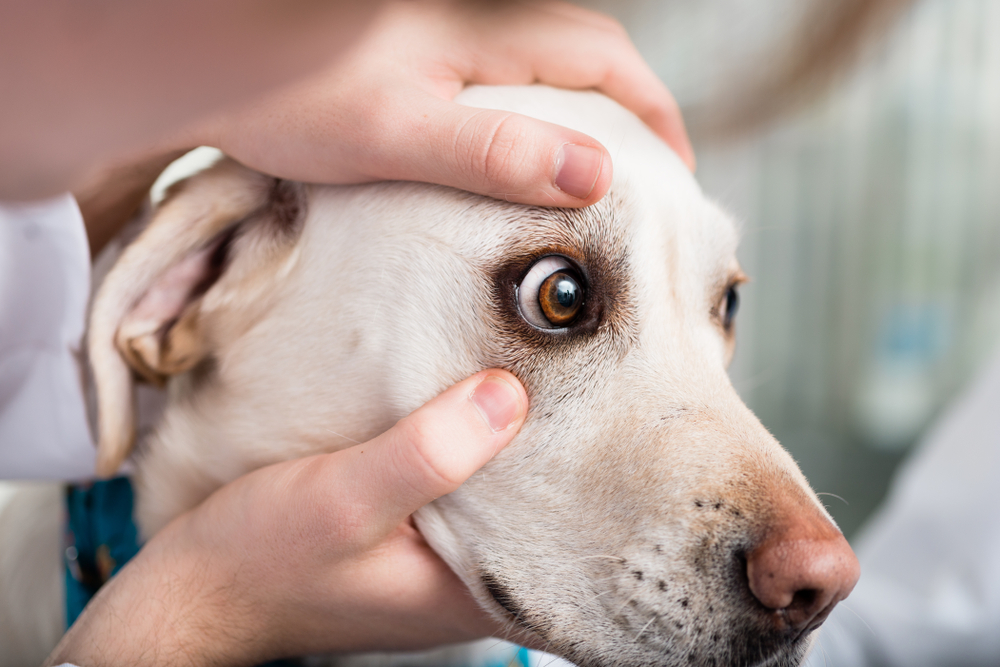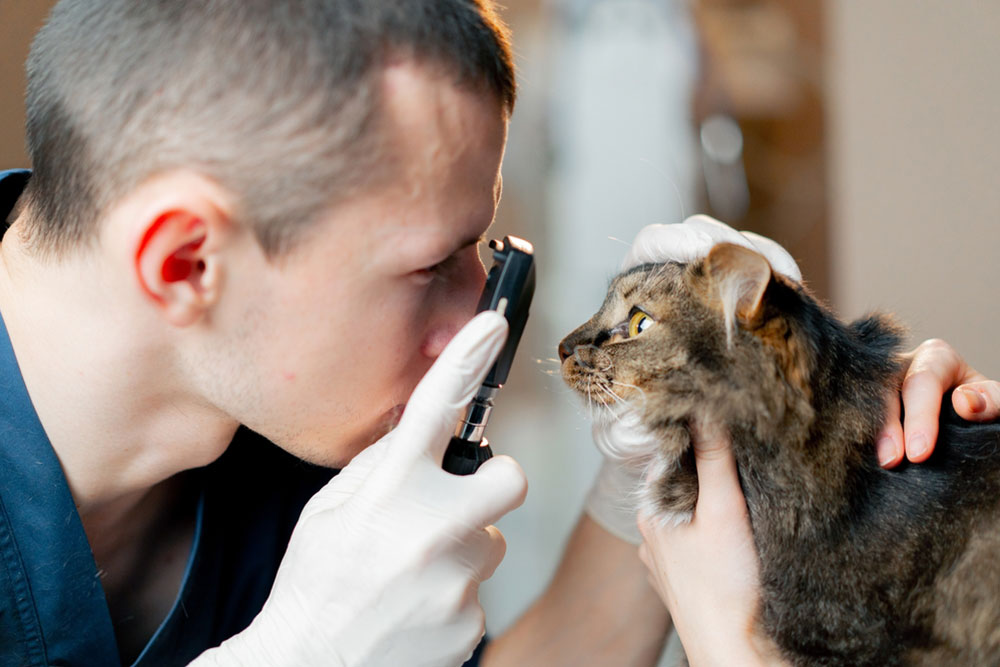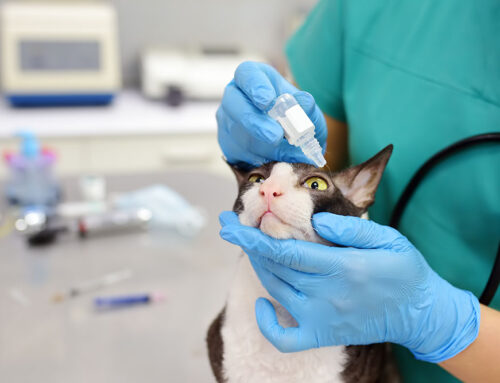When Vision Fades: Understanding Vitreous Degeneration in Pets
The vitreous, which is a gel-like substance inside the eye, can deteriorate with age or disease, causing vision changes or floating spots in a pet’s sight. Vitreous degeneration is common but requires monitoring to rule out retinal tears or detachment. With early diagnosis and careful management, pets often adapt well and maintain a good quality of life.
At Veterinary Vision Center in Shreveport, LA, our board-certified veterinary ophthalmologist provides gold-standard diagnostic testing and treatment for vitreous degeneration and related conditions. Located inside University Veterinary Hospital, we combine world-class expertise with family-style care to help pets maintain comfort and vision throughout their lives.
How the Vitreous Changes as Pets Age
The vitreous body is a clear, gel-like substance that fills approximately 80% of the eye’s volume. Its primary function is to maintain eye shape and support the retina, the light-sensitive layer at the back of the eye responsible for vision. In young, healthy eyes, the vitreous remains firm and transparent, allowing light to pass through unobstructed.
As pets age, the vitreous gradually becomes more liquid. This natural process, called vitreous degeneration, causes the gel to liquefy and sometimes separate from the retina in a condition known as posterior vitreous detachment. While this process is often harmless, it can create visual disturbances and occasionally leads to more serious complications.
Understanding eye structure and function in dogs helps owners recognize why these changes occur and when they require veterinary attention. Our team at Veterinary Vision Center uses advanced diagnostic equipment to evaluate vitreous health and differentiate normal aging from disease.
Comprehensive ocular examinations allow us to monitor vitreous changes over time and intervene when necessary to protect your pet’s vision.
What Causes Vitreous Degeneration in Dogs and Cats
While vitreous degeneration is primarily age-related, several factors can accelerate or complicate the process. Understanding these risk factors helps owners recognize when their pet may need specialized ophthalmologic care.
- Age remains the most significant factor. Just as humans experience vitreous liquefaction over time, older pets naturally develop changes in vitreous consistency. The aging canine eye undergoes multiple structural changes, including vitreous degeneration, that affect vision quality.
- Breed predisposition plays an important role. Certain breeds show higher rates of vitreous degeneration and associated conditions. Terriers, Poodles, and Cocker Spaniels may develop vitreous changes earlier than other breeds, while brachycephalic breeds can experience complications due to their unique eye anatomy.
- Secondary eye disease can trigger premature vitreous degeneration. Chronic inflammation, infections, trauma, and bleeding within the eye all damage vitreous structure. Pets with diabetes, hypertension, or immune-mediated conditions face increased risk of vitreous complications.
- Systemic illness sometimes manifests through ocular changes. Metabolic disorders, cardiovascular disease, and inflammatory conditions can all affect vitreous health, making comprehensive evaluation essential for accurate diagnosis.
Our experienced team evaluates each pet’s individual risk factors and creates monitoring plans tailored to their specific needs.
Recognizing When Your Pet’s Vision Is Changing
Vitreous degeneration doesn’t always cause obvious symptoms, but attentive owners may notice subtle changes in their pet’s behavior or appearance.
- Visual cloudiness sometimes occurs when vitreous opacities develop. While the eye itself may appear hazy, this differs from the white cloudiness of cataracts or the bluish tint of nuclear sclerosis.
- Behavioral changes often signal vision problems. Pets may hesitate before jumping, bump into furniture, or show reluctance to navigate stairs. Some become more cautious in dim lighting or unfamiliar environments.
- Eye discomfort can accompany vitreous degeneration when inflammation or complications develop. Watch for squinting, excessive tearing, or pawing at the eyes. These signs of eye pain require prompt veterinary attention.
- Sudden vision loss represents a medical emergency. If your pet suddenly seems disoriented, walks into objects, or shows dilated pupils that don’t respond to light, contact us immediately for an urgent evaluation.
Early detection through routine eye examinations allows us to identify vitreous changes before they progress to serious complications.
How Veterinary Ophthalmologists Diagnose Vitreous Problems in Pets
Accurate diagnosis requires specialized equipment and expertise. At the Veterinary Vision Center, we use multiple diagnostic techniques to evaluate vitreous health and rule out other conditions.
- Comprehensive ophthalmic examination forms the foundation of diagnosis. Using indirect ophthalmoscopy and specialized lenses, we visualize the vitreous and retina in detail. This allows us to identify opacities, hemorrhage, or detachment that may affect vision.
- Ocular ultrasound provides critical information when vitreous cloudiness prevents direct visualization of internal structures. High-resolution ocular ultrasound for vitreous changes reveals the extent of degeneration, detects retinal complications, and helps guide treatment decisions.
- Differential diagnosis ensures accurate identification. We distinguish vitreous degeneration from similar-appearing conditions such as cataracts, nuclear sclerosis, corneal disease, and inflammatory conditions. Each requires different management approaches.
- Advanced imaging may include electroretinography to assess retinal function or optical coherence tomography for detailed retinal evaluation when available through referral networks.
Our state-of-the-art diagnostic capabilities ensure accurate diagnosis and appropriate treatment planning for every patient.
Understanding Complications That May Develop in Your Pet
While many pets with vitreous degeneration maintain comfortable vision, some develop complications requiring immediate intervention.
- Retinal detachment represents the most serious complication. When vitreous separates from the retina, it can create tears or holes that allow fluid to accumulate beneath the retinal layer. This causes sudden, often permanent vision loss without emergency surgical repair.
- Progressive retinal atrophy may coexist with vitreous changes. This inherited condition causes gradual retinal degeneration, and progressive retinal atrophy in dogs often shows vitreous abnormalities on examination.
- Intraocular inflammation sometimes accompanies or triggers vitreous degeneration. Inflammatory cells and proteins cloud the vitreous, causing discomfort and vision impairment. This requires anti-inflammatory treatment to prevent permanent damage.
- Vitreous hemorrhage occurs when blood vessels break and bleed into the vitreous cavity. Research on vitreous degeneration in dogs shows that hemorrhage can result from trauma, hypertension, or retinal disease.
Our ophthalmology specialists monitor for these complications during routine examinations and provide prompt intervention when problems arise. We treat various ocular conditions with medical and surgical therapies tailored to each patient’s needs.
Treatment Options and Long-Term Management for Your Pet
Treatment for vitreous degeneration depends on severity, underlying causes, and presence of complications.
- Observation and monitoring suits most cases of mild, uncomplicated vitreous degeneration. Regular recheck examinations every three to six months allow us to track progression and detect problems early. Senior pets benefit from more frequent monitoring to catch age-related changes before they become serious.
- Medical management addresses secondary inflammation or underlying disease. Anti-inflammatory medications reduce swelling and discomfort when uveitis accompanies vitreous changes. Treating systemic conditions like hypertension or diabetes helps prevent further vitreous damage.
- Surgical intervention becomes necessary when retinal complications develop. Our team performs advanced surgical therapies including retinal reattachment procedures when indicated. Some cases require referral to specialized retinal surgeons for complex repairs.
- Lifestyle modifications help pets adapt to vision changes. Consistent routines, verbal cues, and environmental management support pets experiencing progressive vision loss.
Regular follow-up appointments ensure optimal outcomes. Contact our team to schedule monitoring examinations for your pet.
Helping Pets Adapt to Vision Changes
Many pets with vitreous degeneration maintain good quality of life with appropriate support and environmental modifications.
- Home environment management reduces stress and prevents injury. Avoid rearranging furniture, as pets memorize layouts and navigate using spatial memory. Keep pathways clear of obstacles and use baby gates to block stairs or hazardous areas.
- Communication adjustments help visually impaired pets respond confidently. Use consistent verbal cues before touching or approaching your pet. Teach commands for “step up” and “step down” to navigate obstacles safely.
- Sensory enrichment compensates for reduced vision. Provide textured surfaces to help pets orient themselves, use scented markers near important locations, and add sound cues like bells on collars of other household pets.
- Safety considerations prevent accidents. Tips for living with a blind pet include using night lights, padding sharp furniture corners, and maintaining consistent feeding and water bowl locations.
Most pets adapt remarkably well to gradual vision loss, maintaining active, happy lives with proper support from their families.
Protecting Your Pet’s Long-Term Eye Health
Vitreous degeneration is common in aging pets, but proactive care makes all the difference in preserving comfort and vision. Early detection through comprehensive eye examinations allows our team to monitor changes, identify complications, and intervene before problems become serious.
At the Veterinary Vision Center, we provide specialized ophthalmologic care with empathy and expertise. Our board-certified specialist offers world-class diagnostic testing and treatment in a family-style setting, ensuring your pet receives the gold-standard care they deserve.
Schedule your pet’s comprehensive eye examination by calling (318) 797-5522 or requesting an appointment online today.








Leave A Comment